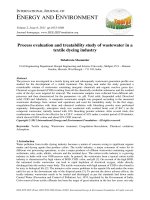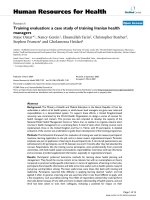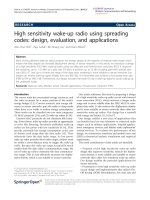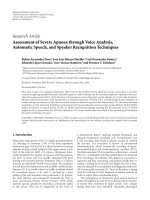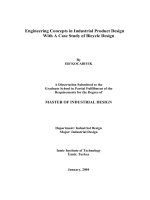EXTENDING INPUT RANGE THROUGH CLUTCHING ANALYSIS, DESIGN, EVALUATION AND CASE STUDY
Bạn đang xem bản rút gọn của tài liệu. Xem và tải ngay bản đầy đủ của tài liệu tại đây (5.06 MB, 98 trang )
EXTENDING INPUT RANGE THROUGH CLUTCHING:
ANALYSIS, DESIGN, EVALUATION AND CASE STUDY
QIAN KUN
(B.S and B.B.A (Hons.), Fudan)
A THESIS SUBMITTED
FOR THE DEGREE OF MASTER OF
SCIENCE BY RESEARCH
SCHOOL OF COMPUTING
NATIONAL UNIVERSITY OF SINGAPORE
January, 2012
Acknowledgement
I would like to thank all people who have helped and inspired me during my
study in National University of Singapore.
I would like to express my deep and sincere gratitude to my supervisor, Dr.
Zhao Shengdong. With his enthusiasm, his inspiration, and patience, he
showed me the fascinating of the field of Human Computer Interaction, helped
me to learn the various aspects of making a good research, and guided me
though my master research period.
I wish to express my warm and sincere thanks to Professor Pourang Irani of
University of Manitoba, Canada, for offering me the summer internship
opportunities in his lab and leading me working on my thesis topic.
I owe my most sincere gratitude to Professor Morten Fjeld of Chalmers
University of Technology, Sweden, who gave me various insights and friendly
help for my thesis, working with him is a very pleasant memory.
I warmly thank Professor Michael Haller, University of Applied Sciences
Upper Austria, for his valuable advice and friendly help for my thesis.
My warm thanks are due to all my lab mates and co-workers, Yi Bo, Kuang
Xiaole, Zhang Haimo, Rubaiat, Yang Xin, Zhou Shaoping, Melissa Wong, Shi
Xiaoming, Yang Xingdong, Grant Partridge, Khalad Hasan, Matthew Lount,
Barrett Ens, for every help they have given to me during my master study.
Last but not the least, I would like to thank my family and friends: my parents
Qian Weiming and Sun Wenqing, for giving birth to me and supporting me
spiritually throughout my life, my girlfriend Zhao Mengyao, for accompany
with me through these tough days and share lift with me. My friend Zhou Rui,
Zhou Yinsheng, Shen Zhijie, Xupeimu, Zhengji Tai, Li Jianlan, Cui Yuanyuan,
for sharing together with my happiness and pains.
Singapore, January 2012
Qian Kun
3
TABLE OF CONTENTS
1. INTRODUCTION ..................................................................... 1
2. LITERATURE REVIEW ......................................................... 5
2.1. CLUTCHING HISTORY ........................................................... 5
2.2. DESIGN OF CLUTCHING TECHNIQUES ................................... 7
2.3. INPUT CATERGRIZATION ...................................................... 8
2.4. MODE SWITCHING ................................................................ 9
2.5. PEN BASED INPUT, TILT AND PRESSURE INPUT ................... 11
3. CLUTCHING USAGE SENARIOS ...................................... 14
4. CLUTCHING ANALYSIS ..................................................... 17
4.1. CAPTURING THE NATURE OF CLUTCHING .......................... 17
4.2. THREE PHYSICAL CONSTRAINTS MAKING CLUTCHING
NEEDED ......................................................................................
20
4.3. USING STATE TRANSITION DIAGRAM TO DESCRIBE
CLUTCHING 1 .............................................................................
22
4.4. RELATIONSHIP IN CLUTCHING STAGES .............................. 24
4.4.1 Sequential relationship among stages ......................... 24
4
4.4.2 Paired relationship among stages ................................ 25
4.5. CLUTCHING DESIGN: FOCUS AND ORDER ........................... 28
5.1. USING SYSTEM CAPABILITIES TO EXPAND THE MODE OUT 31
5.1.1 Use alternative input channels ..................................... 32
5.1.2 Multiplex the same input channel ............................... 34
5.1.3 Using state transition diagram to describe clutching 2 37
5.2. USING TASK CONFLICTION TO NARROW DOWN THE MODE
OUT.............................................................................................
37
5.2.1 Confliction analysis with supported task ..................... 38
5.2.2 Conflict analysis with con-current task ....................... 41
5.2.3 Conflict analysis with sequential task .......................... 42
5.2.4 Using state transition diagram to describe clutching 344
6. CLUTCHING EVALUATION ON PEN TILT ................... 45
6.1. TASK AND STIMULI ............................................................. 45
6.2. PILOT STUDY ...................................................................... 46
6.3. EVALUATION METRIC AND HYPOTHESIS: ......................... 49
6.4. EXPERIMENT PROCEDURE AND DESIGN ............................ 51
6.5. RESULTS AND DISCUSSION ................................................. 52
5
6.6. RECOMMENDATIONS FOR DESIGNING CLUTCHING
TECHNIQUES FOR PEN TILT ........................................................
53
6.6.1 No Clutching versus Clutching Techniques ................ 53
6.1.2 Comparison of Selected Clutching Techniques For Pen
Tilt .......................................................................................... 54
6.1.3 Low Granularity versus High Granularity .................. 54
7. CLUTCHING EVALUATION ON PEN PRESSURE ........ 55
7.1. EXPERIMENT SETTING ........................................................ 55
7.2. RESULTS .............................................................................. 57
7.3 DISCUSSION .......................................................................... 58
7.4 FIVE GENERAL CLUTCHING DESIGN GUIDELINES ............. 59
8. CLUTCHING DESIGN CASE STUDY................................ 61
8.1. PARTICIPANTS AND ENVIRONMENT ................................... 61
8.2. TASK ................................................................................... 62
8.3. METHOD ............................................................................. 64
8.4. RESULTS AND DISCUSSION ................................................. 65
8.4.1 Suggested analysis’ explanatory power ....................... 66
8.4.2 Suggested analysis’ capacity to enhance understanding
................................................................................................ 67
6
8.4.3 Suggested approach’ capacity to support clutching
design ..................................................................................... 68
8.4.4 Shortcomings with the suggested approach ................ 70
9. SUMMARY AND FUTURE WORK .................................... 71
BIBLIOGRAPHY ....................................................................... 73
7
SUMMARY
Most input devices can only express a limited range of values when users
perform a single action. Only few devices, such as the mouse, permit users to
extend device input range through clutching. This thesis presents a general
systematical analysis and design approach for clutching techniques extending
the range of input streams. Firstly, it analyses the nature and cause of
clutching, operation stages in clutching and examines their relationships. The
analysis showed that the sequential relationship and paired relationship
among stages decided the design focus, order and constraints.
Secondly, to
design clutching, the thesis researches how external factors affect the design of
operation stages. We found that system capability and application task work
together to narrow down the design options. Thirdly, two digital pen studies
exemplifies how our design approach can produce range extension in the pen’
tilt and pressure input stream. These two studies showed that when design
clutching, finding a single winning technique might not be feasible. Designers
need to select a few winning candidates for different contexts. Based on all
three, we propose a set of clutching design guidelines for a suite of input
streams and tasks. Finally, we provide an early validation in a design case
study with 8 expert designers showing that our analysis of clutching and
design approach can help other designers to understand clutching better and
support their clutching design for different input streams.
Keywords: Clutching, relative position control, mode switching, input
8
LIST OF FIGURES AND TABLES
Figure 1: Clutching examples with mouse................................................. 1
Figure 2: Clutching examples on the touchscreen pinching gesture.......... 2
Figure 3: Three constraints result in clutching ........................................ 22
Figure 4: Clutching four stage transition diagram. .................................. 23
Figure 5: Paired relationship among clutching stages ............................. 26
Figure 6: Clutching by using different input channels for pen tilt ........... 33
Figure 7: Clutching by multiplexing the same input channel for pen tilt 35
Figure 8: Using different input channels to Clutch .................................. 37
Figure 9: Clutching with a con-current input task. .................................. 42
Figure 10: Confliction analysis using state transition diagram ................ 44
Figure 11: EndZone Clutching Techniques for Pen Tilt. ......................... 46
Figure 12: Lift, Button and Dwell Clutching for pen tilt ......................... 48
Figure 13: Experiment result ................................................................... 52
Figure 14: EndZone Clutching Techniques for Pen Pressure .................. 56
Figure 15– Experiment 2 results .............................................................. 57
Figure 16: Task Setting for design case study ......................................... 64
Table 1: Directional confliction analysis with the supported task
40
9
1. INTRODUCTION
Whenever we interact using a mouse and a screen, we regularly reach an
awkward hand pose or position while moving the device (see Figure 1). Once
this happens, we need to adjust our fingers, hand, and/or arm to a more
comfortable pose and re-engage the device to continue manipulation of the
onscreen cursor [81].
Continuous
Input Mode
Mode
Out
Adjustment
-‐ 2 -‐
Mode
Mode
in
Continuous
Input Mode
Mode Out
Continuous
Input Mode
Tilt(X, Z)
Adjustment
Mode
Mode In
Figure 1: When interacting using a mouse and a screen, the user can extend input
range through clutching (left). A state transition diagram can represent the clutching
process (adapted from Buxton [95]) (right).
This phenomenon is called clutching, it occurs across many categories of input
devices, and can be observed in many computing tasks using relative position
1
control. For example, clutching is frequently performed in the pinching
gesture as users zoom in (or out) a picture displayed on a tablet-computing
device (see Figure 2). Very similar to mouse clutching, touch-based clutching
involves a sequence of user removing, adjusting, and replacing his/her fingers
or hand, rather than moving the device itself.
Continuous
Input Mode
Mode
Out
Adjustment
Mode
Mode
in
Continuous
Input Mode
Figure 2: Clutching examples on the touchscreen pinching gesture.
Clutching is an important operation in human-computer interaction (HCI) and
is needed for many input devices and tasks. However, there is a lack of
research describing clutching and supporting its design. As we enter the
ubiquitous computing era, an increasing number of novel input streams are
introduced such as tactile, gesture, or voice control. However, these input
streams are often brought to the market without proper clutching mechanism,
which represents a gap between their innovative potential and proven
usefulness. This has inspired us to firstly aim for a general design approach
that may fill this gap. Secondly, we aim to showcase our approach using pen
tilt and pressure, as examples of novel input streams capitalizing on tactileand gesture-based input [99]). The general design approach includes the
following four steps:
2
Step1. We analyses the nature and cause of clutching, and based on Buxton’s 3
state model, we describe clutching as a four-stage process (See Figure 1):
continuous input (1), mode out (2), adjustment (3), and mode in (4).
The
sequential relationship (1->2->3->4) and the paired relationship (1&3, 2&4)
guided us to focus on mode out design, as other stages will be constrained by it
and stage 1.
Step2. To design clutching, we identify two main external factors affecting all
stages of clutching: system capability and application task, which directly
affect mode out (2) design and indirectly affect later stages (3, 4). The former
expand the mode out language by examining all afforded actions of the input
devices using different input channels or multiplex the same input channel.
The latter narrows down the design options by confliction analysis with the
supported task, the con-current task or the sequential task. These two steps
further extend our model of clutching.
Step3.
Then we demonstrate our approach in clutching design for pen tilt and
pen pressure, and provided a set of design guidelines.
Step4.
Finally we examine how our clutching analysis and design approach
can benefit other designers though a design case study with 8 expert designers.
The contributions of this thesis are three-fold. First, we come up with a
general systematic approach to analyze and design clutching to extend the
input range. Second, we showcase the effectiveness of this approach in two lab
studies involving the design, analysis, and evaluation of pen tilt and pressure
clutching.
Third, we provide an early validation showing our approach can
3
benefit other expert designers when design clutching for different input
streams.
4
2. LITERATURE REVIEW
We show how clutching is introduced and designed, and how input devices are
categorized according to their properties in the past as background. This is
followed by a literature study on mode switching and pen based input that
related to our design approaches for clutching in pen tilt and pressure.
2.1. Clutching History
Though clutching is as old as relative positioning control, the term “clutch”
was introduced in HCI much later [75]. Researchers also used alternatives
terms such as “ratcheting recalibration mechanism” [54] and “re-clutching”
[81, 52]. Researchers considered clutching as a universal mechanism, which
acted as “an engagement of the link between the control actions and cursor
movements” [80, 88]. This either “repositioned the reference frame of absolute
pointing” [3], or to “avoid running off the input area” [57, 24]. Early works
mostly constrained clutching to a mouse-specific phenomenon [76,52,3]
and defined it as the process of "lifting, adjusting, and repositioning" [76,3].
However the clutching problem becomes interesting when researchers tried to
bring clutching to spatial input devices [81, 76, 52, 3].
While the concept of clutching mostly is treated in brief only, the focus of
novel input techniques is mostly to reduce or even eliminate clutching because
of their cost in user time and motor action [24, 54, 81].
Those researchers
5
focused on the negative aspects of clutching and thus aimed to reduce or even
eliminate it. In a study dated 1990 on variable-acceleration mice (which are
now commonplace), Jellinek et al. noted “lift[ing] and repositioning the
mouse result[s] in degraded performance time.” [30]. Jellinek et al.’s
comment on clutching captures a general appreciation of clutching as a waste
of both user time and motor action. Researchers have therefore been interested
in reducing the need for clutching. Their methods include design measures
promising reduced [24, 25] or even eliminated clutching times [68, 88] for
those input channels that traditionally rely on clutching. For instance,
clutching can be reduced by increasing the ratio of display movement to
control movement (Control-Display gain, or CD gain), but high CD gain can
hurt performance [75, 2, 9, 92]. An alternative is to dynamically adjust CD
gain based on the input velocity, called pointer acceleration [2, 4]. This
technique uses low CD gain at low velocity to improve precision and high CD
gain at high velocity to cover large distances with minimal clutching. For
input channels lacking a conventional means to clutch, current research
focuses on how to improve the accuracy of input sensors using signal
improving transfer functions [13] so that they can operate over a wider
effective range.
Still, most researchers and designers consider clutching to be an issue of
priority when introducing new techniques such as relative direct pen input [9].
In some cases, researchers admit that clutching design is one of the keys to
success with new input devices [2]. However, a good clutching mechanism is
6
hard to design as it jointly relies on device complexity and context of use.
Some researchers believe that poor clutching design is costly and can cause
staggering usability problems with end-users [54, 2]. Such problems will be a
pressing and hard-to-fix for UI designers [54, 11, 73]. Therefore, there is a
need for solid understanding and careful analysis of its process.
2.2. Design of clutching techniques
As an increasing number of sensors are introduced and embedded in
interactive products, UI designers may struggle to design matching clutching
solutions. We believe this may be explained by the lack of design guidelines
on par with sensor technology. Traditionally, lifting devices to initiate the
clutching process can be applied onto certain input devices and tasks such as
rolling the barrel on a pen for map navigation [97], which is preferred by input
device designers [73]. However, for many other input channels, lifting is no
longer used to initiate clutching. In Zhai's paper [81], a button on the mobile
device was used for clutching through a 3D navigation task instead of lifting.
A similar clutching strategy was employed in numerous other works [55, 81,
73, 76, 52, 3, 65].
Researchers also have tried to add the clutch button on secondary devices such
as keyboards or foot pedals [55, 52, 2]. However, this is not always a solution,
as it can create other usability problems [54] and does not work for device-free
interaction in which requires hand or finger gesture for clutching [11,1].
Ramos and Balakrishnan introduced an innovative clutching method, for the
7
pressure stream of a digital pen. They used a specific region of a tablet as a
zone for pressure detection. Sliding the pen outside of that zone triggered
clutching [27]. Finally, clutching using voice input [55] or velocity change
sensing [27, 2, 78] has also been proposed.
Such clutching design is not only random and inefficient, but, to our
knowledge, it is also not systematical. When design clutching, it did not
consider the entire process where different stages are related and affect each
other. However, they did acknowledge that the input device and task could
affect clutching design, such as fingerball and glove clutching [81]. Our
exploration of clutching is based on modes, mode switch, and the four-stage
clutching process suggested here. We leverage the relationship of clutching
stages and external factors to form a general clutching design approach and
guideline.
2.3. Input Catergrization
Input devices have been categorized according to their properties in many
ways such as their mechanical and electrical properties [21, 79], and human
performance [29, 66]. However, these works are often overly device-specific.
Therefore, in order to isolate more fundamental issues, Foley, Wallace, and
Chan [40] took the notion of logical devices [10], identify six generic
transactions that reflected the user's intentions, and categorized input
technologies that capable of articulating each of these basic primitives. Buxton
8
[94] introduced a taxonomy of input devices that was more rooted in the
human motor/sensory system. Build on this work, Mackinlay, Card and
Robertson [86, 45] proposed an input taxonomy that captures a broad part of
the design space of input devices, which can serve as a pragmatic strategy to
examine almost all input channels of the systems. These work provide a clear
way to categorize input devices and their affordance accordingly, however,
there are still significant gaps. To fill in them, Buxton [95] provide another
model takes the form of a simple state-transition model and builds on the work
mentioned above. It can characterize both many of the demands of interactive
transactions, and many of the capabilities of input transducers, which provides
a simple and usable means to aid finding a match between the two. These
researches provide us valuable insights to design clutching, as an important
characteristic of input device.
2.4. Mode switching
Mode switching is an important part of clutching. A comprehensive design
space for it was suggested by Li. [98]. They compared five alternative modes
switching techniques in pen-based user interfaces and provided some
guidelines on designing effective ink-gesture switching techniques for pen.
While their work shed some light on how we can adopt mode switching
techniques for clutching purposes, their design is limited to pen-based input
and not systematic. Other works provided some general design requirements
9
for mode switches such as “quick”, “predictable, "minimally disruptive” [98],
and “easy-to-access mode switches space” [50]. Modes can cause a significant
of errors, confusion, unnecessary restrictions, and complexity in interfaces
[43]. Researchers have tried different ways to alleviate it such as providing
clear depiction of mode to the user [31]. Another important way is to design
effective mode switching techniques. One kind of mode switching techniques
is based on inference based approaches [72], its performance restricted by the
techniques that discern the two modes, which may resulted in narrow and
constrained usage. For instance, many tablet systems support an immediate
delete command indicated by a scratch-out gesture where no explicit actions
are required to switch mode, while other gestures are not robust due to the
recognition problems. Another kind of mode switching techniques leverage on
the help of user mediation [17], through explicit motor action [42, 89], it could
provide users with consistent mechanisms that are applicable across a wide
variety of applications. Examples include using a foot pedal in an interface to
control music sequencing software [18], pressing a button to enter command
mode [98, 56, 16, 22], moving the input device in certain direction to trigger
gesture mode [98, 91], employing different physical hardware for draw and
edit functions [98, 83, 67, 39], or holding the input device motionless to
activate a type of special mode [98, 17, 87].
10
2.5. Pen based input, tilt and pressure input
Research in pen-based input is getting popular these years because of its
advantage in mobile and creativity usage [53, 96, 70]. Tablets these days can
accurately detect pen pressure, and pen tilt and rolling angles. To fully
utilizing these extra degrees of freedom, rigorous studies have been conducted
to investigate users’ ability to control pen pressure [28], rolling [97], and tilt
[99]. These studies showed that these input channels provide additional
continuous degree-of freedom that can be utilized. However, all these
auxiliary input channels have limited ranges, which restrict them only been
used by a few drawing and image manipulation programs, like Adobe
Photoshop, to modulate limited parameters of the active brush, such as stroke
thickness or color opacity. Therefore, discovering useful ways to expand the
limited bandwidth of them could dramatically redefine the way these devices
are used and increase their utility in special applications.
Among all auxiliary input channels, tilt offers extra primary feedback because
the angle of the pen implies the expressed value, which could be beneficial for
eye-free interaction. Tilt input has been widely explored as an additional input
channel and become a standard hardware component of many small formfactor devices, such as digital pen, digital cameras, and smart phone.
Researchers have explored the capability of tilt input and demonstrated its
feasibility [46,35,37,48,12, 63, 99]. Different muscle groups can operate tilt
input. Finger based control, such as pen tilt [20, 19, 99, 23, 74, 64], provide
finer and precise control. Wrist based control, such as mobile device tilt [51,
11
61, 60, 47, 5, 58, 14, 6], provide coarse control. Tilt based control also has
been introduced to large input devices, such as TiltTable [33] where users
interact with by lifting it up and tilting the table’s surface in a given direction.
Though these work has demonstrate the usefulness of tilt input when entering
text, controlling menu, navigating documents, or scrolling through a set of
images. However, current tilt-based systems still not be fully utilized because
of the input limited range [63, 19].
Human’s ability to control pressure input has been explored in many research
works [8, 93, 62, 71], researcher found that that appropriately designed
pressure-sensitive interaction techniques could be a practical alternative to
standard movement-based methods. Researchers have integrated pressure
sensors into existing devices such as mouse [41, 49], pen and tablet [27, 26],
and mobile devices [77, 13, 85]. Ramos and Balakrishnan explore integrated
panning and zooming by concurrently controlling input pressure while sliding
in x-y space [27]. They then study the possibility of using integrated spatial
movement and pressure input for concurrent selection-action operations [26].
The properties of force-based input on a handheld device were examined in
[77], they suggested that smaller force ranges should be considered in future
implementations of force input. Pressure also has been explored in mobile
texting contexts [32, 13, 85] and been reported that pressure input is a valuable
augmentation to mobile phone keypads. Though promising, pressure input
also suffered from limited range problem Srinivasan and Chen suggest that
pressure interfaces need to have a force resolution of at least 0.01N to make
12
full use of human capabilities [62]. Mizobuchi et al. [77] suggest that ranges
of 0-3N are comfortable and controllable and users can reliably apply around
5-6 levels of pressure [77, 28].
Reviewing literature indicates that clutching is an important operation in HCI
and is needed in many input devices and tasks. However, the sources we
consulted did not offer a systematic analysis to thoroughly describe and design
clutching. As we seek to understand the role and nature of clutching we
examine the relationship between ach of its stage, hence aiming for a unified
analysis.
13
3. CLUTCHING USAGE SENARIOS
Clutching is needed in many different scenarios where limited input streams
need to extend their input range. Before go to the main part of this thesis, we
will first look at some of the practical usage scenarios that clutching can
benefit to get an initial understanding of what kind of problem clutching can
resolve and how clutching works.
Scenarios 1: User Who Holds a Mobile Device for Multi-DOF Input Control
[81]
Mike is a 3D graphic designer. In order to view his creations from a wide
variety of angles, he manipulates a mobile phone with tilt sensors and
gyroscopes, which analogously adjust the angle from which his 3D object is
displayed. As he tilts the mobile phone, the on-screen 3D object tilts similarly.
However, Mike is limited by the capabilities of his wrist, and cannot possibly
twist his phone to view the object from all possible sides. With clutching
techniques, he can adjust his hand when he reaches the extent of his possible
motion tilt again to view the object from any angle.
Scenarios 2: User Whose Hands Are Occupied and Can Only Use Foot Tilt (in
x-y plane) to Perform Menu Selection
Jerry is returning from a shopping trip, listening to the MP3 player in his
pocket. Since both of his hands are occupied with shopping bags, he cannot
14
use them to interact with his music player. An interface based on tilting the
foot to make a menu selection would enable hands-free control, but without
clutching, it would be impossible to select songs from any list of practical size
because of limited tilt angle of the foot [44]. With clutching techniques,
however, it would be possible to adjust his foot position when encounter the
input limits and continue to increase the input value to engage more
effectively with the device.
Scenarios 3: User Who Uses Finger Pressure Instead of a Mouse
Tom is a handicapped person who is only able to control his fingertip to
operate the computer [59, 90]. Rather than using a mouse, he uses finger
pressure as a primary input stream to control his TV. However, conventional
mappings of pressure to list selections constrain Tom to a limit of 4 to 6
channels to choose from, which is problematic [28]. With the help of clutching
mechanism, he could perform several smaller actions of 4-6 to linked together
to increase the channel beyond such an impractical limit.
Scenarios 4: User Mainly Uses Pen to Draw, Using Tilt or Pressure to
Change Function [19]
Jenny is a digital graphic designer. While drawing with her digital stylus and
tablet, she likes to use the angle of her pen (tilt) to change color, adjusting her
pressure on the stylus to change the thickness of her stroke. She does this
while maintaining the drawing activity uninterrupted. Previously, she could
15
only accurately choose from a few color, size and thickness options. With an
appropriately designed clutching technique, she can access the full range of
these parameter values exposed by Photoshop through repeated tilt and
pressure action. (In Photoshop’s color panel, there are 122 options by default;
its font size usually ranges from 1-72pt, and the thickness of brushes can be
set anywhere between 1-2500px).
Summary
Though these scenarios leverage on different body parts, operate different
kinds of input devices, and for different purpose, we notice that there are
several things that are common to all usage scenarios: 1) the input devices and
their supported tasks have the same kind of relationship 2) the needs for
clutching to extend the range are similar that can be categorized. 3) clutching
techniques can resolve the problems in a similar manner. These findings
indicate there is a need to analyze clutching in details to understand it better
and support future clutching design.
16
